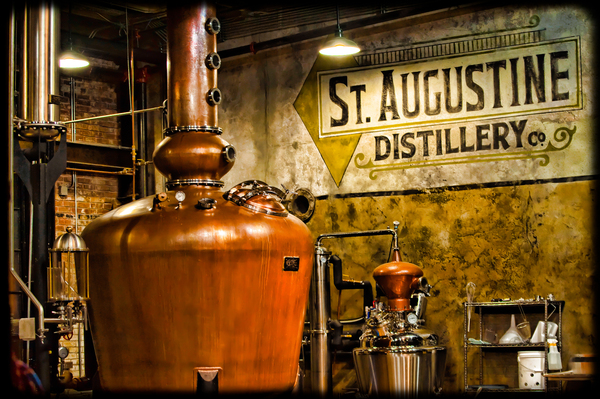Historic St. Augustine, Florida, offers a rich mix of history, charm, and exceptional cuisine. Known as the oldest city in the U.S., it blends ancient landmarks with modern culture, making it an ideal getaway for couples, families, or friends. From historic sites to top-rated restaurants, St. Augustine is a must-visit for anyone seeking unique experiences. As a 20-year local, I’ve explored every part of this beautiful city. In this guide, I’ll share my favorite things to do in St. Augustine, covering everything from sightseeing spots to the best dining experiences. Plus, you’ll find a few hidden gems that even some locals don’t know about!
Why Historic St. Augustine is a Must-Visit Destination
St. Augustine, located 30 minutes south of Jacksonville on Florida’s First Coast, is steeped in history. Known as the “Oldest City” in the U.S., it was founded in 1565 by Spanish explorer Pedro Menéndez de Avilés. Today, the city’s Spanish influence remains evident in its architecture, cultural landmarks, and cuisine.
Walking through the historic district is like stepping into another time. With landmarks like Castillo de San Marcos, and the charming St. George Street, visitors can enjoy cobblestone walkways, cozy cafes, and artisan shops. Whether you’re interested in history, relaxing at the beach, or savoring delicious food, St. Augustine has something for everyone.
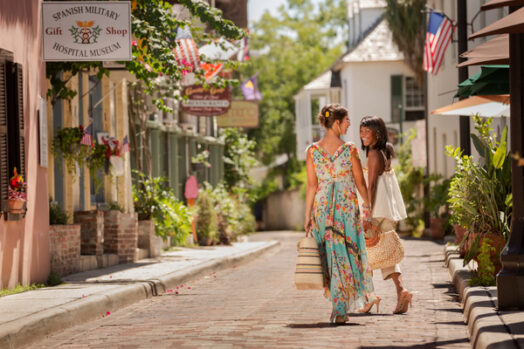
Just a little personal story here: I’ve lived in this part of Florida for 20 years, but I’ve been coming to St. Augustine my entire life. A great aunt lived here and we’d often come here on family vacations because they lived near the beach. My parents came to St. Augustine on their honeymoon in 1957 and my father took a picture of my mom at the Castillo. My brother brought her back here 60 years later to recreate that same photo. It might be my favorite photo of all time!
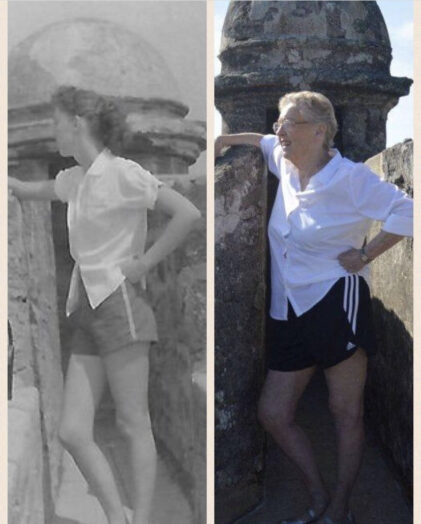
The History of St. Augustine
Founded in 1565 by Spanish explorer Pedro Menéndez de Avilés, it holds the distinction of being the oldest continuously inhabited European-established settlement in the continental United States. Walking its cobblestone streets feels like stepping back in time, offering a glimpse into centuries of exploration, colonization, and cultural evolution.
The Spanish Influence
St. Augustine’s roots are deeply tied to Spanish exploration and colonization. The city served as a strategic military outpost and a hub for trade routes during Spain’s dominance in the New World. Its iconic Castillo de San Marcos, a massive stone fortress built between 1672 and 1695, stands as a testament to Spanish engineering and military strategy. Today, visitors can tour the fort and witness reenactments of cannon firings, immersing themselves in the colonial era.
Over the centuries, St. Augustine endured pirate attacks, sieges, and territorial battles. It shifted between Spanish and British control before ultimately becoming part of the United States in 1821. Despite these turbulent times, the city preserved much of its original charm and architecture, showcasing a blend of Spanish, Moorish, and Mediterranean influences.
Gilded Age Elegance
The late 19th century ushered in a new era of prosperity for St. Augustine, thanks to industrialist Henry Flagler. Recognizing its potential as a winter resort destination, Flagler invested heavily in the city’s development, constructing luxurious hotels like the Ponce de León Hotel (now Flagler College). This period brought elegance and grandeur, cementing St. Augustine’s reputation as a cultural and leisure destination.
Today, St. Augustine seamlessly blends its historical charm with modern amenities. Visitors can explore landmarks like the Lightner Museum, stroll down St. George Street for unique shopping and dining experiences, or take a scenic boat tour along Matanzas Bay. The city’s commitment to preserving its rich history makes it a captivating destination for history buffs, families, and cultural enthusiasts alike.
What to Do in Historic St. Augustine
From historic landmarks to picturesque beaches, there’s no shortage of activities in St. Augustine. Here are some top picks that both tourists and locals love.
Explore St. Augustine’s Historic Sites
The city is home to some of the most iconic sites in the U.S. If you’re wondering what to do in Historic St. Augustine, start with these must-see attractions:
Castillo de San Marcos
Constructed between 1672 and 1695, Castillo de San Marcos is one of the most iconic historic structures in St. Augustine. This 17th-century fortress, constructed by the Spanish, is the oldest masonry fort in the continental United States. Its well-preserved coquina walls and strategic location along the Matanzas River provide a glimpse into colonial military engineering. You can attend ranger-led talks, witness reenactments, and watch weapon demonstrations in period attire.
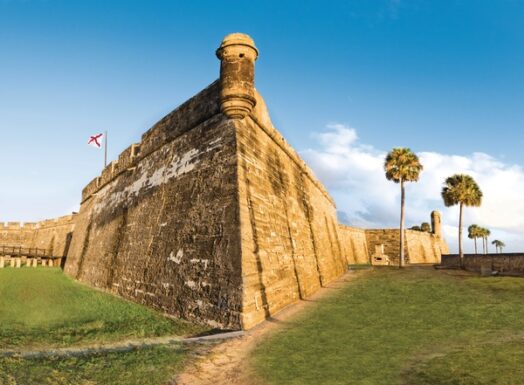
Lightner Museum
Housed in the former Alcazar Hotel, built in 1887, the Lightner Museum offers a unique glimpse into 19th-century life. Inside, you’ll find an array of artifacts, costumes, and furnishings from the Gilded Age. It’s a top destination for history lovers.
TIP: Eat lunch at the Café Alcazar which sits on what was the hotel’s large indoor swimming pool.
Ximenez-Fatio House Museum
Dating back to the early 19th century, this well-preserved boarding house offers a window into the lives of 19th-century residents and travelers. The museum highlights the significant role of women in St. Augustine’s history.
Fountain of Youth
St. Augustine’s Fountain of Youth Archaeological Park commemorates where Ponce de León’s quest led him in 1513. Although the legend is debatable, the park itself is an engaging spot to explore. Located on 15 waterfront acres, it offers historical exhibits, a Spanish watchtower, and trails through a beautiful riverside setting. The park features exhibits on Timucua Native American history, a planetarium, and opportunities to sample the famed spring water.
Flagler College
Formerly the opulent Hotel Ponce de Leon, built by industrialist Henry Flagler in 1888, this architectural masterpiece showcases Spanish Renaissance style with intricate details, including Tiffany stained glass windows. Guided tours provide insights into its lavish past.
St. George Street
This pedestrian-only thoroughfare is lined with historic buildings, charming shops, and eateries. Strolling along St. George Street offers a vibrant blend of the old and new, capturing the essence of St. Augustine’s rich heritage.
Fort Matanzas National Monument
Located a short drive south of downtown, this fort was built by the Spanish in 1742 to guard the southern approach to St. Augustine. Accessible via a scenic boat ride, it provides insights into the city’s defensive strategies during colonial times.
For visitors looking for a convenient way to explore the city’s historic sites, St. Augustine’s trolley tours offer a hop-on, hop-off experience. The Old Town Trolley Tours allow you to ride through the city’s cobblestone streets while listening to entertaining and informative narrations about the area’s history. With multiple stops near top attractions, visitors can get off to explore and hop back on when ready to continue their journey. Tickets often include discounts to museums and other attractions, making it a budget-friendly way to see the city.
Relax at St. Augustine Beach
I grew up going to St Augustine Beach as a child and I’ll tell you, it hasn’t changed that much. Known for its soft, white sands and stunning natural beauty, it’s one of Florida’s top beaches with a perfect blend of natural beauty, history, and relaxation along Florida’s Atlantic coast. It’s located on Anastasia Island where you can rent paddleboards, kayaks, or simply relax by the shore. If adventure is more your thing, there’s hiking, and wildlife spotting. It’s a perfect escape for families or couples looking for a scenic beach day and it is a favorite destination for sunbathing, beachcombing, and water sports. Visitors can also explore the historic St. Augustine Lighthouse and Maritime Museum, which offers stunning views of the coastline. Whether you’re looking for outdoor adventure or a peaceful retreat, St. Augustine Beach and Anastasia Island provide an idyllic escape.

The Best Restaurants in St. Augustine
As a local and a foodie, this is a tough one. There are SO many great restaurants in St. Augustine that I can’t possibly list them all so I’m focusing on those with unique cuisine and unique features. The city’s dining scene offers a diverse range of flavors, with options that showcase both local and international cuisine.
Start your day at Ancient City Brunch Bar, famous for its brunch charcuterie boards. Unlike traditional meat and cheese boards, these feature French toast sticks, frittatas, and other brunch classics that make for a delicious start to any day.
One of the city’s oldest and most beloved restaurants, Columbia Restaurant serves up flavorful Spanish and Cuban dishes. The menu includes favorites like Paella a la Valenciana, Pompano en Papillot, and the iconic 1905 Salad. It’s a must-visit for those who love bold, international flavors.
For innovative Southern fare, The Floridian is a favorite among locals. Be sure to try the grit cakes, fried green tomatoes, and Mayport shrimp, a regional delicacy. Another popular spot is The Ice Plant, located in a repurposed 1927 ice plant building. Here, you’ll enjoy farm-to-table dishes and exceptional craft cocktails. Be sure to stop by the St. Augustine Distillery downstairs for a whiskey tasting.
Two of my personal favorites (although there are MANY) are Lotus Noodle Bar where Chef Barry Honan prepares chef modern Japanese craft ramen and Llama which serves Peruvian cuisine in a tiny 10-seat restaurant. Oh wait! There’s one more! La Nouvelle is an ahhh-mazing French restaurant in the historic district.
A few others I’ll mention are The Reef on Vilano Beach, Caps on the Water on Vilano Beach, Sainte-George Restaurant, Asado Life, and Casa Reina.
TIP: Always make dinner reservations in St. Augustine, especially for these smaller, more intimate restaurants.
The Best Hotels in St. Augustine
Generally, whether you’re looking for a cozy bed and breakfast or a luxurious hotel, historic St. Augustine has accommodations to suit every preference.
For a unique experience, try staying in one of the city’s charming bed and breakfasts. My personal favorite is The Collector Inn, a collection of nine historic homes turned into luxury B&Bs. The onsite bar, The Well, is the perfect spot to relax with a late-night cocktail by the fire pit.

For those seeking luxury, Casa Monica Resort & Spa is a top choice. Located in the heart of the historic district, this hotel offers a rooftop pool and the popular Cordova restaurant. They also have my favorite spa in the area, Poseidon, which has great day spa packages. Read my lengthier post on the Casa Monica.

The Local is one of those kitschy on-school motels that is authentically Florida and very highly rated.
Top Events: Nights of Lights in St. Augustine
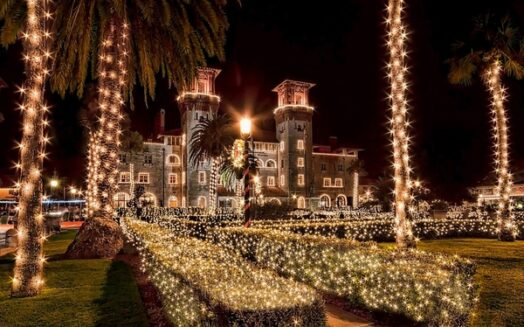
One of St. Augustine’s most magical events is the annual Nights of Lights, which illuminates the historic district with over three million lights from mid-November through January. Additionally, it is named one of the world’s top 10 holiday light displays by National Geographic, so it’s a can’t-miss experience if you’re visiting during the holidays. For a quieter experience, plan to visit in January after the holiday crowds have thinned.
St. Augustine offers a unique blend of historical charm, beautiful beaches, and mouth-watering cuisine. Whether you’re exploring centuries-old forts, savoring local dishes, or simply relaxing by the sea, there’s something for everyone. Plan your trip well, and be prepared to fall in love with this enchanting city.
Planning Your Visit
Whether you’re drawn to its Spanish heritage, architectural beauty, or coastal charm, St. Augustine offers something for everyone. Be sure to schedule a guided tour to learn about the legends and lore that make this city truly magical. And don’t forget to sample some of the local cuisine influenced by its Spanish roots—you won’t be disappointed!
St. Augustine is more than just a destination; it’s a living museum that tells the story of America’s earliest chapters. A visit here promises to leave you inspired by its resilience, beauty, and enduring legacy.
Getting to St Augustine and Getting Around
St. Augustine is conveniently accessible by car via Interstate 95, making it an easy drive from major Florida cities like Jacksonville, Orlando, and Miami. For those flying in, Jacksonville International Airport is the closest major airport, located about 50 miles to the north. Once in St. Augustine, getting around is a breeze. The city is compact and pedestrian-friendly, but there are also trolley tours and bike rentals available, even horse-drawn carriages, providing fun and convenient ways to explore the historic sites and scenic waterfront.
When Is The Best Time To Visit St. Augustine?
Let me start by saying, this is Florida, the sunshine state so the weather is pretty nice year round. As a local, I advise people to avoid the high season and particularly the holidays. The best time to visit St. Augustine is during the spring (March to May) and fall (September to November) when the weather is pleasantly warm, and the crowds are smaller. These seasons offer ideal conditions for exploring outdoor attractions and historic sites without the heat and humidity of summer. The city’s Nights of Lights, held from November through January, is another popular time to visit but the city can be ridiculously crowded. If you want to visit for the lights, I suggest the first and last weeks of the event.
If you’re planning a visit to St. Augustine and have specific questions, feel free to drop them in the comments section below and I’ll respond!
This blog post may contain affiliate links, meaning that if you click on a link and make a purchase, I may receive a small commission at no extra cost to you. I only recommend products and services I truly believe in and use myself.


